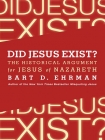Did Jesus Exist? - The Historical Argument for Jesus of Nazareth Bart Ehrman (books to read in your 20s txt) 📖

- Author: Bart Ehrman
Book online «Did Jesus Exist? - The Historical Argument for Jesus of Nazareth Bart Ehrman (books to read in your 20s txt) 📖». Author Bart Ehrman
The letters of Ignatius are nothing if not interesting.6 The ones he wrote to the various churches are filled with exhortations to strive for unity and to follow the leadership of the bishop. Moreover, they attack the views of Christians who in the opinion of Ignatius represent “false opinions,” that is, heresies. Some of the letters oppose forms of Christianity that continued to insist on keeping Jewish laws and customs. The ones I am most interested in here, however, are those that oppose Christians who insisted that Jesus was not a real flesh-and-blood human. These opponents of Ignatius were not ancient equivalents of our modern-day mythicists. They certainly did not believe that Jesus had been made up or invented based on the dying and rising gods supposedly worshipped by pagans. For them, Jesus had a real, historical existence. He lived in this world and delivered inspired teachings. But he was God on earth, not made of the same flesh as the rest of us.
Ignatius finds this view repugnant and completely at odds with who Jesus really was, as he states in the most emphatic terms possible in the following passages, once again worth quoting in full. First, from a letter that Ignatius wrote to the Christians in the city of Smyrna:7
For you are fully convinced about our Lord, that he was truly from the family of David according to the flesh, Son of God according to the will and power of God, truly born from a virgin, and baptized by John that all righteousness might be fulfilled by him. In the time of Pontius Pilate and the tetrarch Herod, he was truly nailed for us in the flesh—we ourselves come from the fruit of his divinely blessed suffering—so that through his resurrection he might eternally lift up the standard for his holy and faithful ones, whether among Jews or Gentiles, in the one body of his church.
For he suffered all these things for our sake, that we might be saved; and he truly suffered, just as he also truly raised himself—not as some unbelievers say, that he suffered only in appearance. They are the ones who are only an appearance; and it will happen to them just as they think, since they are without bodies, like the daimons. For I know and believe that he was in the flesh even after the resurrection. (Ignatius to the Smyrneans 1–2)
From these quotations it is crystal clear what Ignatius thought of the real existence of Jesus. He was fully human; he was really born; he was really baptized; he was really crucified. Even though there are allusions to traditions that made it into the Gospels, there is no conclusive evidence to suggest that Ignatius is basing his views on the books that later became part of the New Testament. The same can be said of his plea to the Christians of the town of Tralles:
And so, be deaf when someone speaks to you apart from Jesus Christ, who was from the race of David and from Mary, who was truly born, both ate and drank, was truly persecuted at the time of Pontius Pilate, was truly crucified and died, while those in heaven and on earth and under the earth looked on. (Ignatius to the Trallians, 9)
Ignatius, then, provides us yet with another independent witness to the life of Jesus. Again, it should not be objected that he is writing too late to be of any value in our quest. He cannot be shown to have been relying on the Gospels. And he was bishop in Antioch, the city where both Peter and Paul spent considerable time in the preceding generation, as Paul himself tells us in Galatians 2. His views too can trace a lineage straight back to apostolic times.
1 Clement
The letter of 1 Clement was written by the Christians in Rome to the church of Corinth in order to straighten out what was to them an unsatisfactory turn of events. The leaders of the Corinthian church had been ousted from power and replaced by others, and the Roman Christians, at least those responsible for the letter, did not like the situation. The letter is meant to urge the church in Corinth to return their “elders” to their rightful place.
It is a long letter filled with warnings against jealousy and the thirst for power. It is attributed by tradition to the fourth bishop of Rome, Clement, even though the letter itself does not claim to be written by him. Clement is never even mentioned in the letter. Be that as it may, there are compelling reasons for thinking that the letter was written sometime during the 90s CE, that is, some twenty years before Ignatius and at about the time some of the later books that made it into the New Testament.8 The letter quotes extensively from the Greek Old Testament, and its author explicitly refers to Paul’s first letter to the Corinthians. But he does not mention the Gospels of the New Testament, and even though he quotes some of the sayings of Jesus, he does not indicate that they come from written texts. In fact, his quotations do not line up in their wording with any of the sayings of Jesus found in our surviving Gospels.
It is all the more impressive that the author of 1 Clement, like Ignatius and then Papias, not only assumes that Jesus lived but that much of his life was well known. Among the many things he says about the historical Jesus are the following:
Christ spoke words to be heeded (1 Clement 2.1).
His sufferings were “before your eyes” (2.1).
The blood of Christ is





Comments (0)